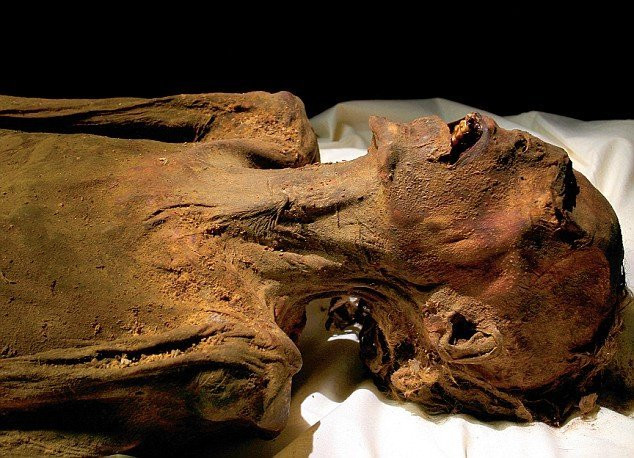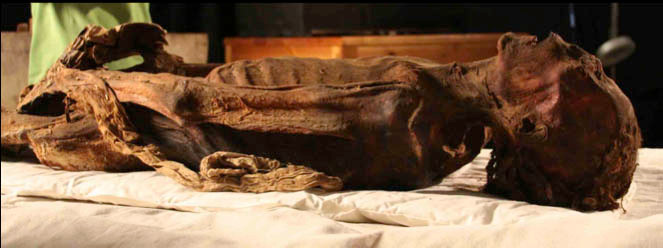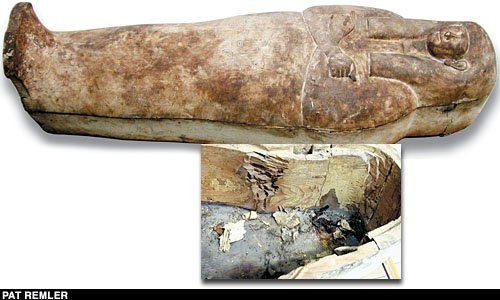The mummy’s contorted face showing its horror prompted Egyptologists to search for the identity of the dead for many years.
In 1881, archaeologists discovered 40 mummies in a secret cave with code DB320 in Deir El Bahri, 483km south of Cairo, Egypt. Among these, they found an anonymous mummy that was not buried according to custom at the end of a 14m high steep tunnel containing countless corridors.
When they opened the cloth wrapped around the mummy in 1886, they were extremely surprised to see the dead man’s terrified expression as if he were screaming, according to Ancient Origins.
The mummy was in a coffin without any names or identifying marks, so scientists could not conduct further research. They called the mummy by the name “Unknown Man E” or “Screaming Mummy”, and kept it at the Cairo Museum.
 “Screaming mummy” with a look of horror on his face. (Photo: Ancient Origins).
“Screaming mummy” with a look of horror on his face. (Photo: Ancient Origins).
At that time, researchers hardly paid attention to “Unknown Man E” because his body was placed next to many famous Egyptian kings such as pharaoh Ramses II, pharaoh Seti I, and pharaoh Thutmose III. ” These are really big names in ancient Egyptian history ,” commented Dylan Bickerstaffe, an Egyptologist and consultant for National Geographic.
All 40 mummies were transported to the cave from the pyramids in the Valley of the Kings . Experts say that by the end of the Ramesside period, tomb robberies became a serious threat, threatening royal mummies. Therefore, high-ranking priests decided to hide dozens of mummies in remote locations.
 “Unknown Man E” because his body was placed next to many famous Egyptian kings.
“Unknown Man E” because his body was placed next to many famous Egyptian kings.
They buried all valuables with the mummy but still kept the name of the dead person. According to ancient Egyptian belief, a skeleton without a name cannot identify it and cannot enter the afterlife. For this reason, some experts concluded that “Unknown Man E” was most likely cursed to live forever in hell because his coffin had no symbols to help identify his identity.
In 2008, a group of Egyptologists investigated the case of “Unknown Man E” with the support of National Geographic. Before the study, they came up with three hypotheses about the identity of the dead. According to one theory, the “Screaming Mummy” belonged to an Egyptian who held the position of governor. The servants may have buried the body in an unconventional manner, using quicklime to dry the body and scattering pieces of sheep and goat skin over the owner’s body.
 Most likely, the screaming mummy was cursed to live forever in hell.
Most likely, the screaming mummy was cursed to live forever in hell.
To the Egyptians, sheep and goats were dirty animals. Covering the body with the skin of these animals is to prevent the dead from going to the afterlife. However, in many other places, sheep and goat skins are common in burial customs because they are often used as clothes and blankets. The research team rejected this theory because the body of ” Unknown Man E” was next to royal family members and the burial seemed to intentionally leave no identification marks on the coffin.
The second theory is that “Unknown Man E” was a foreign prince who died while in Egypt. Due to conflicts between countries, the prince’s body could not be transported back to his homeland in time, so he was buried in Egypt. However, this hypothesis does not help explain the location of the body’s burial and intentionally does not record the identity of the undertakers.
 “Unknown Man E” is Egyptian.
“Unknown Man E” is Egyptian.
Computed tomography scan of the skeleton shows that “Unknown Man E” is Egyptian. His skull even had some characteristics of Egyptian royalty such as shape, size, long skull from forehead to back of the head and indentation at the top of the skull.
The research team is inclined to conclude: “Unknown Man E” was a member of the royal family who fell out of favor at the time of pharaoh Ramses III’s death. This person is most likely Prince Pentewere , the son of pharaoh Ramses III accused of plotting to kill his father. “This mummy was influenced by two psychological streams: one tried to deny and the other tried to preserve,” said Bob Brier, an archaeologist at Long Island University, New York, USA, who examined the mummy this year. know.
 “Unknown Man E” was a member of the royal family who fell into disgrace at the time of Pharaoh Ramses III’s death.
“Unknown Man E” was a member of the royal family who fell into disgrace at the time of Pharaoh Ramses III’s death.
Documents recorded on papyrus tell of a trial that took place around the 12th century BC. Tiye, the first wife of pharaoh Ramses III, was accused of plotting to kill the king to put her son Pentewere on the throne. Tiye and his accomplices were taken to execution. Due to his royal lineage, Prince Pentewere was allowed to commit suicide by drinking poison. Some researchers believe that Tiye fell from favor because pharaoh Ramses married a new, younger and more beautiful wife. After Ramses III died, his second wife’s son succeeded him, taking the name Ramses IV. An unmarked grave can be a way of punishment for those who commit treason.
The identity of “Unknown Man E” attracted a lot of interest because of the corpse’s horrifying expression. However, most Egyptologists agree that the terrifying facial expression was just the result of the deceased falling backwards and hitting his head backwards. Archaeologists plan to conduct DNA testing in the near future to determine the relationship between “Unknown Man E” and pharaoh Ramses III.





